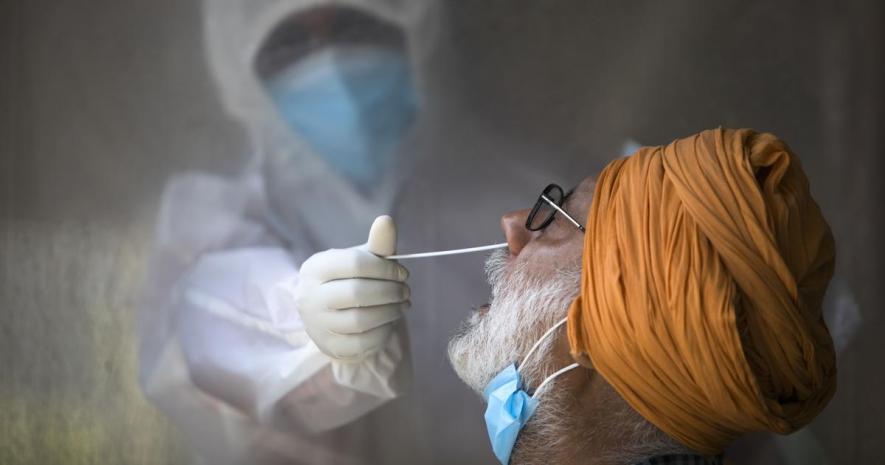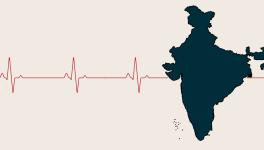COVID-19: Low Contact Tracing, Less Vaccination, Govt Laxity Behind Surge in Punjab

Image Courtesy: AFP
Punjab is witnessing a huge crisis in terms of the spike in COVID-19 cases with the state recording over 3,000 cases on a daily basis. As per the latest notification, poor contact tracing, shortage of manpower and low testing have emerged as major hurdles in the government’s attempt to contain the virus. Contact tracing is considered as fundamental to stop the virus from transferring to others.
In the last 24 hours, 3,119 new cases have been reported in the state, taking the total tally of the cases to 2,72,772. Further, a sharp increase can be seen in the daily new cases in Punjab from January (500) to April (3500) (see graph below). The maximum cases of 530 positive patients have been reported from Ludhiana in last 24 hours termed as “single-day spike” since March 2020. Yet, contact tracing in Ludhiana reportedly still very low.

As per the sources, in the backdrop of surge in the cases, the state government is enhancing contact tracing essentially in Patiala and Ludhiana. Despite that, the pace at which tracing is taking place currently – 13.4 contacts per case - is much lower than the expected tracing rate of 25-30 underlining the poor execution of the state government.
Speaking to NewsClick, Hussan Lal, Principal Secretary, Department of Health and Family Welfare said, “Who is doing 25-30 per positive cases testing? Nobody is doing. But we are improving the testing count.”
As per the sources, state government is focussing on testing 20 individuals per positive patients. It is pertinent to note that a year has gone by since the pandemic gripped the country, and yet, there is no RT-PCR testing laboratory in Rup Nagar, formerly known as Ropar which shares its borders with Mohali and Chandigarh. Notably, there is not even a dedicated COVID-19 Hospital in Mohali, officially known as SAS Nagar and Rupnagar districts. The positive patients in these districts are referred to either neighbouring districts or Chandigarh.
Speaking about the COVID-19 facilities, Hussan said, “We don’t have Level 3 COVID (dedicated COVID-19 hospitals) facility in Ropar and Mohali but we do have enough ambulances to carry patients to nearby districts. However, Level 1 and 2 COVID facilities are available.”
Amid this terrible state of healthcare, what is even more worrying is the low rates of vaccination in Punjab. One day ago, Punjab’s Chief Minister had referred to the farmers’ anger against the central government as a major reason behind the low vaccination rate in the state. "People in Punjab are still not coming out in large numbers for vaccination due to the massive anger prevailing against the Government of India on the issue of farm laws. This anger is impacting the vaccination drive,” Captain Amarinder Singh said on Saturday, April 10, during a video conference convened by Congress president Sonia Gandhi to discuss the COVID-19 situation in the country.
However, the figures show a different picture. Three months ago, when the vaccination drive started, the government’s first priority was to protect its health and frontline workers. But, in Punjab, even after three months, only 60% health and front-line workers have received their first shot. Health care workers include doctors, nurses, midwifes, paramedical staff, ASHA workers, Anganwadi workers and medical students, among others who are health care providers and
workers. Frontline workers are those who are engaged in surveillance and containment activities and includes Personnel from State and Central Police organisation, Armed forces, Home guards, Prison staff, Municipal workers, revenue officials, among others.
Until April 11, around 1.57 lakh health care workers have received their 1st dose of vaccine and only 71,263 have received their 2nd dose. In comparison, 2.9 lakh front line workers have received their 1st dose of vaccine and only 61,367 have received the 2nd dosage.
As per the official figures, there are around 2.05 lakh health care workers, which means only 34.76% of health care workers have received the 2nd dose of COVID-19 vaccination and only 76.58% have received the 1st dosage of vaccine in last 3 months. In contrast, only 20.45% of frontline workers have been vaccinated for second dosage against 3 lakh registered frontline workers.
Dr. Rajesh Bhaskar, COVID-19 Nodal Officer, pointed at the indifference among the workers. Speaking to NewsClick, Bhaskar said, “The indifference among the health care workers is the reason behind the low numbers. The workers are taking the virus casually and think they can fight the virus on their own.”
Also read: COVID-19: India Sees Highest Daily Tally of Cases This Year
As per the experts, in the backdrop of shortage of manpower, if health workers get infected, Punjab will land in a huge crisis. As opposed to the official version of blaming people and the healthcare workers’ attitude, there are questions on the availability of the vaccines as well. Two days ago, CM Singh had raised alarm when he said that state’s COVID-19 vaccine stock will only last another five days. However, Bhaskar said that they have received “a batch of 4 lakh” vaccines on April 11, which is less given that more than a lakh workers are yet not covered.
Among the healthcare workers, ASHAs (Accredited Social Health Activists) and anganwadi workers are reportedly demanding that unless the government meets their long-pending demands they will not get vaccinated. Kirandeep Kaur, president of ASHA Workers and Facilitators Union in Punjab, said, “When COVID started a year ago, we were named as frontline workers but were hugely ignored as we were not even provided with masks, sanitisers. We took take care of ourselves on our own. With the low wages, we get, we bought sanitizers and masks.”
She added, “ASHA workers are not getting vaccinated because not even a single demand of ours have been met including wages and promotion. We believe this is the only way to catch the government's attention. However, we are getting others vaccinated and taking care of ourselves.”
Meanwhile, last month, a remark by Punjab Health and Family Welfare Minister Balbir Singh Sidhu had drawn flak when he had reportedly said that those who don’t get vaccinated won’t be given another opportunity. “If health workers get infected at a later stage, they will have to bear the cost of their treatment and will not be allowed quarantine/isolation leave,” Sidhu had said.
Also read: How True are Claims About Bonded Migrant Labourers in Punjab?
Get the latest reports & analysis with people's perspective on Protests, movements & deep analytical videos, discussions of the current affairs in your Telegram app. Subscribe to NewsClick's Telegram channel & get Real-Time updates on stories, as they get published on our website.
























